|
|
About
the Robert Bebb Herbarium (OKL)
The
Robert Bebb Herbarium is maintained jointly by the Oklahoma
Biological Survey
and the Department
of Botany & Microbiology
of the University of Oklahoma. The Herbarium is
housed on the second floor of George Lynn Cross Hall with the
Department of Botany and Microbiology.
| History - The Herbarium
at the University of Oklahoma originated with Edwin C. DeBarr in
1893 when he announced that 450 mounted plants were given to the
herbarium. The number of collections increased to over 10,000
specimens by 1902 due to the combined efforts of Prof. DeBarr and
Albert H. Van Vleet. The original collection was destroyed in the
1903 fire that destroyed University Hall and much of the rest of the
university. After the fire, an intensive collection effort was
initiated in the summer of 1903 and a new herbarium was begun. A
new Science Hall was completed in 1904 and became home to the
science collections including the Herbarium. The Herbarium's next
move was into the Pharmacy Building in 1925 where it stayed until
1937 when the Botany and Zoology Departments moved into a new
Biology Building (later named Richards Hall). The Robert Bebb
Herbarium moved into its present location in George Lynn Cross Hall
(Botany & Microbiology building) in 1965. |
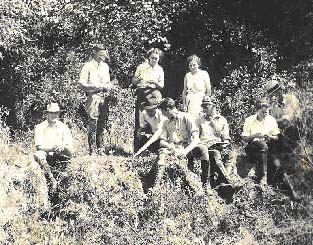 |
|
G. Cross, G. Goodman, et al.
Fieldtrip in Canadian Co., 1935
|
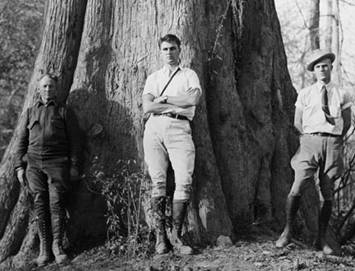
D. Demaree, N. Boke, B. Boke
Oklahoma's big bald cypress, 1936
| Supervision and Growth -
Royal E. Jeffs became the first designated Curator of the Herbarium
in 1927 with the establishment of the Oklahoma Biological Survey.
After Dr. Jeffs died in 1933, George J. Goodman was hired to serve
as Curator of the Herbarium, which housed approximately 10,000
specimens as it did at the time of the 1903 fire. Dr. Goodman
established a friendship with Robert Bebb. When Dr. Goodman left to
accept the position of Herbarium Curator at Iowa State University in
1936, Milton Hopkins was appointed Curator and continued the
relationship with Mr. Bebb. In 1942, the Board of Regents
commemorated the contributions of Robert Bebb by naming the
Herbarium in his honor. By the time of Dr. Hopkins' resignation in
1945, the collection numbered about 80,000 specimens. Dr. Goodman
returned to
University of Oklahoma as Professor of Botany in 1945 and served as
the Curator of the Robert Bebb Herbarium until his retirement in
1975. Dr. Goodman's tenure as Curator lasted 33
years and witnessed a doubling in the size of the botanical
collections to around 170,000 specimens. Johnnie L. Gentry Jr. was
appointed as Goodman's curatorial successor in 1975; he reorganized
the herbarium according to the Cronquist system of classification.
After Dr. Gentry resigned, James R. Estes was appointed Curator in
1979 and served in that capacity for 18 years until his retirement
in 1997. Dr. Estes oversaw continued growth and development of
herbarium collections and facilities. From 1998 to 2001, Mia
Molvray was the Curator. Wayne J. Elisens began his current
appointment as Curator of the Bebb Herbarium in 2001. |
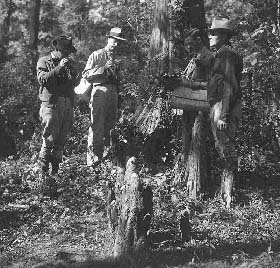
|
|
M. Hopkins, W. Felkner, G. Cross
Botanizing in SE Oklahoma, 1937
|
For
further reading:
Rice,
E. L. and G. L. Cross. A History of the Department of Botany
and Microbiology at the University of Oklahoma: The first hundred
years. University of Oklahoma Foundation. 145 pp.

Robert
Bebb - The herbarium is named for Robert Bebb, a Muskogee floral
company owner and amateur botanist. His personal collection of over
30,000 specimens was donated to the University upon his death. The
majority of his collections were from Oklahoma, but there also were
many specimens from Illinois, Indiana, Texas, Minnesota, California,
and the Rocky Mountain states. In 1942, the Board of Regents
honored this contribution by naming the herbarium for him -- the
Robert Bebb Herbarium.

The
OKL collection - OKL houses the largest collection of Oklahoma
plants in the state and maintains active, collections-based research
programs. Collections exceed 208,000 vascular plant specimens, less
than 500 algal and fungal specimens, and ca. 1500 lichen and
bryophyte specimens. OKL has extensive collections of Poaceae,
Asteraceae, Fabaceae, Cyperaceae, and Rosaceae, and of the genera
Carex, Eriogonum, and Quercus. Some notable
botanists whose collections reside at OKL include: B. F. Bush, G.
J. Goodman, E. L. Little, G. W. Stevens, C. S. Wallis, and U. T.
Waterfall. Noteworthy exsiccatae include F. J. Lindheimer's Texas
collections and J. L. Reveal's western U. S. collections. The Bebb
Herbarium has more than 220 type specimens, which are kept apart
from the main collection in a separate cabinet. Also housed at OKL
are complete sets of voucher specimens from inventories of Wildlife
Management Areas, Bureau of Land Management properties, and the
National Park Service installations in Oklahoma.
The library contains >3200 volumes, a large reprint collection, and the OKL archive.

George J. Goodman - George Jones Goodman served as curator from
1933-1936 and again from 1945-1975. He was Curator Emeritus until
his death in 1999. During his tenure as curator, Dr. Goodman added
thousands of specimens to the
collections making up the Bebb Herbarium. Dr.
Goodman was a leading expert in the field of plant taxonomy who
authored 73 publications, described 36 new plant taxa, made nine new
combinations, and had four plants named for him. In 1975, the Board
of Regents honored Dr. Goodman by naming the herbarium foyer for him
- the George J. Goodman Foyer.
Organization
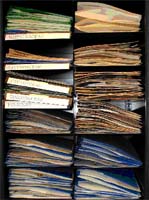 - The Bebb Herbarium is regional in scope. Approximately
75% of its collections represent Oklahoma plants with ancillary
concentrations representing the Great Plains, the southern and
western USA, and Mexico. Specimens are grouped by family and
organized according to the Cronquist system of classification.
Within a family, specimens are filed alphabetically by genus and
species names. A four-color folder filing system is utilized.
Manila folders contain specimens from Oklahoma, blue folders contain
specimens from the rest of North America, green folders contain
specimens from the rest of the world, and pink folders contain
cultivated specimens. The
acronym assigned by Index
Herbariorum
for the Bebb Herbarium of the University of Oklahoma is OKL.
- The Bebb Herbarium is regional in scope. Approximately
75% of its collections represent Oklahoma plants with ancillary
concentrations representing the Great Plains, the southern and
western USA, and Mexico. Specimens are grouped by family and
organized according to the Cronquist system of classification.
Within a family, specimens are filed alphabetically by genus and
species names. A four-color folder filing system is utilized.
Manila folders contain specimens from Oklahoma, blue folders contain
specimens from the rest of North America, green folders contain
specimens from the rest of the world, and pink folders contain
cultivated specimens. The
acronym assigned by Index
Herbariorum
for the Bebb Herbarium of the University of Oklahoma is OKL.
Services
provided - The Bebb Herbarium provides assistance for plant
identification within the academic, research, and governmental
communities; supplies information requests consistent with its
mission, and provides specimen loans to research or academic
institutions.
Service
requests from for-profit organizations are subject to review by the
Curator and may be assessed service fees.
Mission
Statement - The mission of the Bebb Herbarium is to document
and to promote understanding of plant diversity in the state of
Oklahoma and adjacent regions. There are three primary components
to our mission: 1) to support basic and applied research in the
plant and environmental sciences, 2) to support educational
activities related to the life sciences, and 3) to promote awareness
of Oklahoma's flora and vegetation to the scientific community,
professional organizations and agencies, and the interested public.
The specimens housed in the herbarium must be maintained in good
condition and arranged in an orderly fashion to facilitate use by
authorized individuals.
This
page is sponsored by the Oklahoma Biological Survey
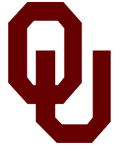
Disclaimer
|








 - The Bebb Herbarium is regional in scope. Approximately
75% of its collections represent Oklahoma plants with ancillary
concentrations representing the Great Plains, the southern and
western USA, and Mexico. Specimens are grouped by family and
organized according to the Cronquist system of classification.
Within a family, specimens are filed alphabetically by genus and
species names. A four-color folder filing system is utilized.
Manila folders contain specimens from Oklahoma, blue folders contain
specimens from the rest of North America, green folders contain
specimens from the rest of the world, and pink folders contain
cultivated specimens. The
acronym assigned by
- The Bebb Herbarium is regional in scope. Approximately
75% of its collections represent Oklahoma plants with ancillary
concentrations representing the Great Plains, the southern and
western USA, and Mexico. Specimens are grouped by family and
organized according to the Cronquist system of classification.
Within a family, specimens are filed alphabetically by genus and
species names. A four-color folder filing system is utilized.
Manila folders contain specimens from Oklahoma, blue folders contain
specimens from the rest of North America, green folders contain
specimens from the rest of the world, and pink folders contain
cultivated specimens. The
acronym assigned by